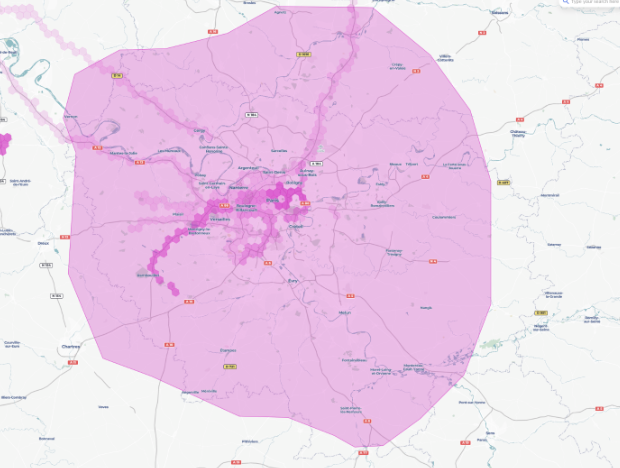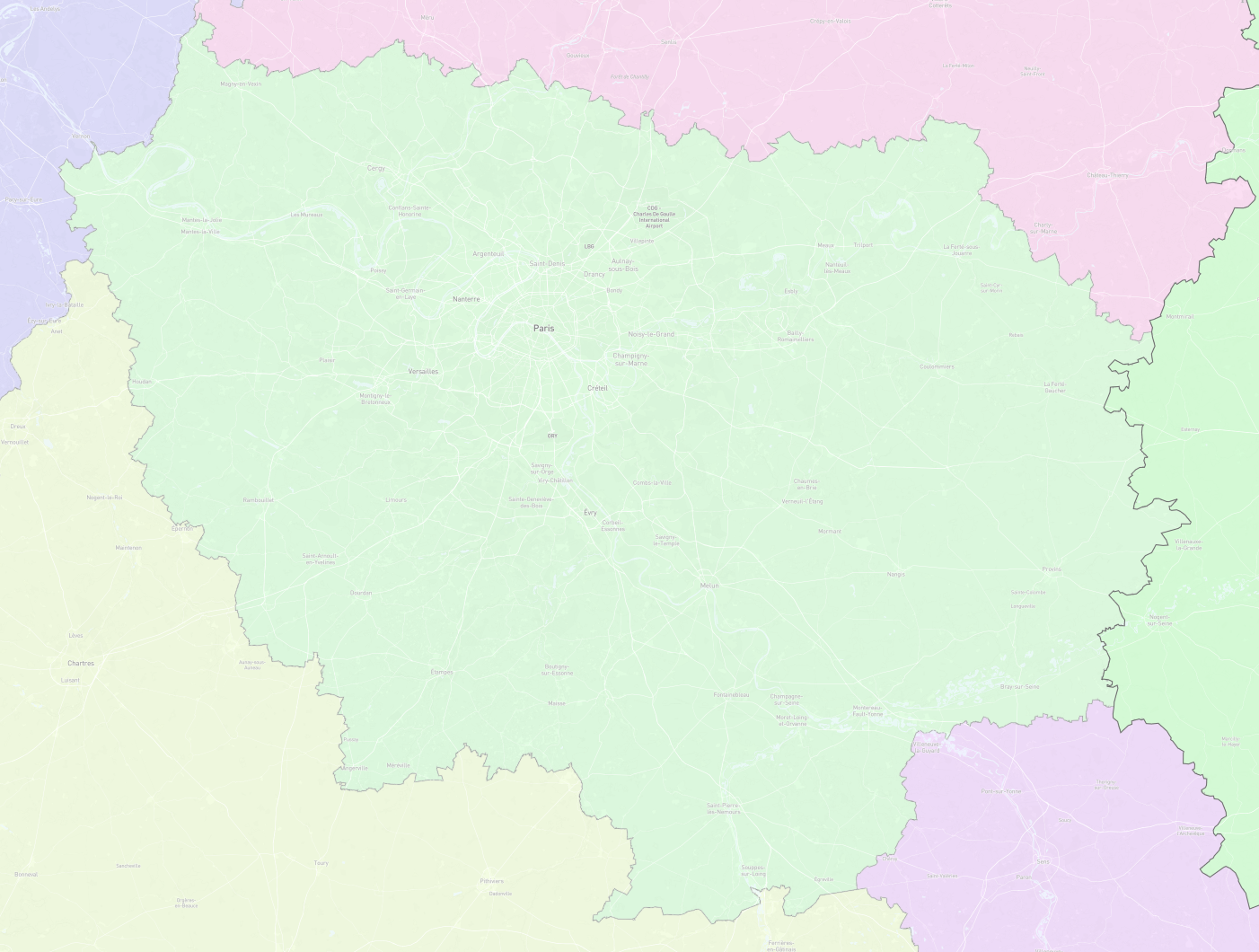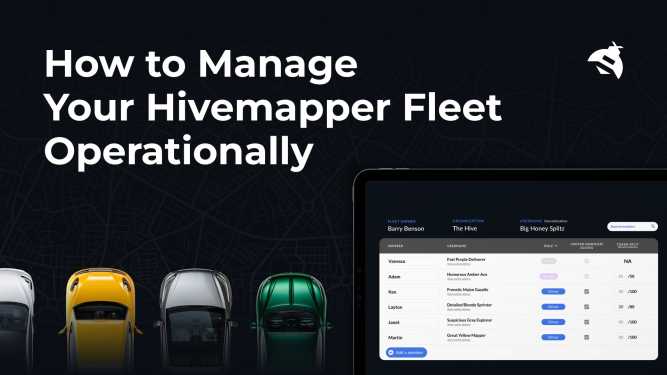The Latest Buzz
Implementation of MIP-2

This blog post was originally published by the Hivemapper Foundation on its blog: https://medium.com/hivemapper-foundation.
A larger HONEY rewards pool, more fairly distributed
On March 10, the Hivemapper Foundation published a Map Improvement Proposal, known as MIP-2, with the objective of improving the incentives for Hivemapper map contributors.
To quote that post:
Over the first several months of the Hivemapper network, some problems emerged with how region boundaries and region weights influence the incentive structure at this early stage of the project. As a result, HONEY tokens are being minted far too slowly … Today, the Hivemapper Foundation is releasing a plan for addressing these problems. The planned changes would take effect in late March 2023, resulting in a larger weekly rewards pool, a more evenly distributed rewards pool across regions, and targeted bounties for high priority regions that will demonstrate the value of the Hivemapper Network to customers.
The proposal included three initiatives:
- Temporarily deactivating regions with no map contributions since network launch, and outlining principles for activating new regions
- Revising the region weight formula to reduce variance in earnings per km
- Launching targeted bounties to more quickly get high-priority regions to 100% coverage
The proposal was well received and led to a spirited discussion on the Hivemapper Discord, with 30+ users posting 200+ comments in the #mip-2 channel during the comment period.
Today, effective immediately, the Hivemapper Foundation is finalizing MIP-2 with several modifications prompted by community feedback.
Implementation of the final MIP-2 plan has already begun. Region deactivations, region activations, and boundary changes are already beginning to appear on Hivemapper Explorer. A new region weight formula will retroactively apply to the current March 13-19 reward cycle, and the first rewards using these new weights will be paid on March 22.
Expanded Bounty for South Korea
The biggest change in the final version of MIP-2 is that the Hivemapper Foundation will now fund a bounty for all of South Korea, rather than just the Seoul metropolitan area. All regions of South Korea will now share the bounty of 10 million HONEY through individual region-level bounties that are sized in proportion to each region’s share of road kilometers in the country.
Like the proposal, this final plan includes seven bounties of 10 million HONEY apiece. This is the first application of a new bounty system that any holder of HONEY can use to incentivize map coverage in a specific area. These seven bounties, covering London, Paris, Madrid, Tokyo and the entire countries of Portugal, South Korea and the Netherlands, will be funded by the Hivemapper Foundation from its own HONEY holdings rather than from the weekly rewards pool.
South Korea has been among the most enthusiastic adopters of Hivemapper, with more than 125 contributors in the Seoul region alone -- more than any region outside the United States.
However, coverage has also been growing quickly in smaller cities such as Busan and Daegu, and even in more remote areas such as the island of Jeju off the Korean peninsula’s southern coast. Contributors from South Korea suggested that 100% nationwide coverage was in reach, and a nationwide bounty would help accelerate that progress.
“I don't understand why [the bounty] only applies to Seoul and not the whole country,” Discord user @bjh7332 wrote in a comment proposing the change. “Korea has a lot of map coverage activity throughout the country. Koreans overwhelmingly ordered the first dashcam and have been the most enthusiastic about the project. Koreans are very crypto-friendly and are very active and influential in information sharing and crypto activities. South Korea deserves to be included.”
Even though this change will result in a smaller bounty for Seoul, which is home to the largest share of map contributors in the country, dozens of active Korean users gave a thumbs up in a strong demonstration of unity.
Keep reading for more details on community feedback and additional changes to the proposal.
Revised proposal
Besides the South Korea bounty, the Hivemapper Foundation made four main changes to the final version of MIP-2 in response to community feedback on the proposal. These are:
Updated design for bounties
Under the final plan, the Hivemapper Foundation will use the existing bounty functionality in a different way by allocating its HONEY across multiple regions within a targeted area. This will incentivize broader coverage across an entire country or metropolitan area, rather than allowing early adopters in a specific area of the country or metropolitan area to claim the entire bounty.
Each targeted country or metropolitan area will now have multiple regional bounties that still add up to the proposed total of 10M HONEY tokens. Each regional bounty will have a limit that is proportional to that region’s share of the road km within the country or metropolitan area. In addition, country bounties in Portugal, South Korea and the Netherlands will now offer a 2x rather than 1x match on base Map Coverage rewards – the same as the metropolitan area bounties for London, Paris, Madrid and Tokyo – ensuring that every map contributor receives 3x the Map Coverage rewards that they would receive in the absence of a bounty.
This graphic explains the new bounty design. For more details, see the sections below on our Philosophy for Region Boundaries and the Appendix on Bounty Details.
Accelerated region activation and deactivation timeline
Several users shared concern that a guideline of four weeks of contributor activity to activate or deactivate a region was too long. Based on this feedback, the threshold will be changed to three weeks of activity or inactivity for a region to be activated or deactivated. Region activation and deactivation will remain at the discretion of the Hivemapper Foundation. For more details on how region activation will work, see the FAQ section below.
Increased number of regions temporarily deactivated
The original proposal was to temporarily deactivate regions with no activity since the launch of the Hivemapper network on Nov. 3 2022. This was inconsistent with the guideline of three weeks of activity to trigger the activation or deactivation of a region. For the internal consistency of the MIP-2 plan, the Hivemapper Foundation decided to temporarily deactivate any regions with no activity since Feb. 23, three weeks prior to the implementation date. This resulted in the temporary deactivation of 21 incremental regions for a total of 197 regions deactivated. These regions accounted for 33.2% of total weight; with no other changes, this change would be expected to grow the weekly global rewards pool by approximately one-third. Under the policy outlined above, these regions will be eligible for reactivation once the Hivemapper Foundation observes three consecutive weeks of contributor activity in the area.
Revised region weight formula
One of the goals of the plan was to solve a problem where the size of region boundaries have led to too much variance in rewards between equivalent regions. The proposal suggested that a fixed component might be applied to the weight formula. During the comment period, it became clear that this would introduce a new problem: disproportionately rewarding small regions. (For an explanation of why, read the next section.)
Under this final plan, the region weight formula will now be based on two factors:
- Road volume, i.e. the number of kilometers of road in the region
- A softened road density factor that dramatically reduces the negative impact to HONEY rewards of driving in a region with low density
When looking at Hivemapper Explorer, you might notice a large difference in weight between regions with a large road volume, such as Los Angeles, and regions with a small road volume, such as Singapore. It is important to remember that the weight numbers on Hivemapper Explorer are not normalized for road volume.
When normalizing the new weight formula for road volume, we expect roughly a 2x difference in weight/km (and therefore HONEY/km, all else equal) between the highest rewarded and lowest rewarded regions.
Including a softened road density factor will fairly result in higher rewards for high-density regions where map data tends to be worth more per km because of the greater population and economic activity. This also fairly reflects the increased time commitment per kilometer in high-density areas where driving speeds tend to be slower due to congestion and urban design.
Discussion of region weights
At the Hivemapper Foundation, we think it’s important to admit when we’re wrong. And when we proposed adding a fixed factor to region weight, we were wrong. Unfortunately, the math doesn’t work. A fixed factor would not reduce variance in HONEY rewards across regions; instead, it would increase variance and disproportionately benefit small regions.
For that reason, the new weight formula will still be based primarily on two variable factors: road volume and density.
This reflects the fact that map data from places with more population and more economic activity has more value to end customers. However, the density factor has been significantly softened to reduce variance between regions. As mentioned above, we expect roughly a 2x difference in weight/km (and therefore HONEY/km, all else equal) between the highest rewarded and lowest rewarded regions.
To understand why a fixed factor doesn’t actually work, imagine a world with 100 km of roads and two identical regions with 50 km of road apiece, which we’ll call Region A and Region B.
If weight is based solely on road volume (the number of km’s) both regions will have a weight of 50%. If weight is based on a fixed component, both regions would still have a weight of 50%. Either way, drivers across the two regions would receive the same amount of HONEY tokens for driving 1 km of fresh road. That’s fair, because these regions are identical and their map data has the same value. However, this approach completely breaks down when regions are different sizes.
Now, let’s imagine that Region B gets split into 50 regions with 1 km of road apiece.
If weight is based solely on road volume, then Region A will have a weight of 50% and each of the 50 regions that replaced Region B would have a weight of 1%. In this scenario, drivers across the two regions would still receive the same amount of HONEY tokens for driving 1 km of fresh road.
That’s because HONEY rewards are based on both weight and region progress. Although the smaller regions have a 50x lower weight, their region progress is 50x higher. It all evens out, resulting in the same HONEY rewards for driving 1 km in two regions of very different sizes.
If weight is fixed across regions, all 51 regions would have a weight of just under 2%. That sounds fair, right? Unfortunately, it’s not. Because the 50 small regions have only 1 km of road, it would only take 1 km of driving to get to 100% coverage for the week, and the contributors in the small regions could receive 50x more HONEY rewards per km submitted. That is clearly unfair; these regions are similar in every way except for how we set the weights.
We recognize all this is not particularly intuitive. There is a strong tendency to look at region weight as an indicator of the potential rewards in a region, without normalizing for road volume.
In the near future, we will deploy improvements to the Hivemapper Explorer to make this clearer to contributors. In the meantime, we will also update the HONEY Rewards Calculator to help people understand how rewards differ across regions.
Philosophy on Region Boundaries
Hivemapper aspires to be consistent and objective in its methodology for defining regions. This is a topic of interest to contributors, who tend to associate themselves with a region and take great pride in improving region progress. It is also important because region boundaries affect region weights, and therefore HONEY rewards.
Weights and HONEY rewards must always reflect the value created for the network, or in other words, customer demand for the map data generated. For fairness, the Hivemapper Foundation relies on objective proxies for the value of map data, such as population and road volume. However, as outlined by the example of Edmonton and Calgary in last week’s blog post, this can result in excessive variance in region weights if region boundaries are not consistently drawn.
In preparation for MIP-2, the Hivemapper Foundation did extensive research on widely-used statistical and administrative boundary methodologies such as Europe’s NUTS ("Nomenclature of territorial units for statistics") system. NUTS is widely used in Europe; the European Commission uses it to harmonize statistical methods across member states and EU-adjacent countries, while European public entities use it to procure goods and services.
NUTS has three levels: NUTS3, NUTS2 and NUTS1. Region boundaries are smallest at the NUTS3 level, aggregating up to a larger area at the NUTS2 level and a still larger area at the NUTS1 level.
The Hivemapper Foundation decided to use NUTS3 as the starting point for defining Hivemapper regions in Europe, starting with the new boundaries being deployed in France, the Netherlands, Portugal, Spain and the United Kingdom. The rationale is that the administrators of NUTS have already taken the time to standardize their regions by population size, which is a crucial proxy for economic activity and thus the value of map data.
With a few exceptions, the population of a NUTS area must fall within a fairly tight range. At the NUTS3 level, for instance, most areas have between 150k and 800k people. This is enough to encompass the entirety of a small-to-midsize metropolitan area, while a very large metropolitan area may be composed of several regions that each have their own weight. As a result, a NUTS3 region in the Netherlands will have about the same amount of people as one in Portugal or France; using these boundaries will result in lower variance between regions on the Hivemapper network and allow metropolitan areas of all sizes to be more fairly incentivized.
These images show the previous Paris region, the NUTS1 region for Paris and the NUTS3 regions for Paris that we intend to use moving forward.
The Hivemapper Foundation will use a similar approach in other countries that do not use NUTS, attempting to maintain a roughly comparable population size per region. Japan and Korea do not use NUTS, but they have similarly standardized ways of looking at their boundaries.
For more details, see the Appendix on Bounty Details.
FAQ
When will all these changes take effect?
Implementation of the final MIP-2 plan has already begun. Region deactivations, region activations, and boundary changes started to appear on Hivemapper Explorer on Thursday, March 16. Changes to region boundaries, weights and bounties will take effect over the next few days and will retroactively apply to the March 13-19 reward cycle, with rewards issued on March 22.
When will my region be activated?
Under this plan, a significant population center will be eligible to become a defined region once it shows three consecutive weeks of map contributor activity. A defined region will be eligible for deactivation once it shows three consecutive weeks of inactivity. Areas that are not significant population centers will generally not have regions added even if they show consistent activity; highways running through unpopulated rural areas are one example.
The Hivemapper Foundation has full discretion to make decisions about region activation and deactivation. Activation is dependent on the completion of GIS work to define region boundaries. This means that regions may not be created as soon as the three-week threshold is met. However, the Hivemapper Foundation has already done extensive work to define planned nationwide boundaries for the most active countries on the Hivemapper Network. This will allow new regions to be activated fairly quickly once a region hits the three-week activity threshold.
In rare circumstances, the Hivemapper Foundation may decide to activate a region early to foster the growth of the network. For example, this plan includes activation of all regions in Portugal (even those with no activity yet) to accelerate progress to 100% coverage across the country.
How can I request that a region be activated?
A population center will be eligible to become a defined region once it shows three consecutive weeks of map contributor activity. The Hivemapper Foundation makes activation decisions at its discretion and will not activate regions or change their boundaries upon request. To inform its decisions, the Hivemapper Foundation welcomes input on regions that contributors would like to see created or updated. Please use this Google Form to share feedback.
Why are the boundaries of existing regions changing? Why are some large metropolitan areas being split into multiple smaller regions?
The previous boundaries were not drawn with a consistent or objective methodology, which resulted in distortions in region weight and rewards. The new boundaries use existing, credible administrative and statistical boundaries that were chosen to reduce the variance in weight and rewards between regions. Breaking up large metropolitan areas into smaller regions allows for a fairer distribution of region weights. Although a smaller region within a large metropolitan area may have a lower weight, it will also have an easier time generating high region progress.
How do you expect these changes to affect rewards?
We designed this plan to deliver a larger weekly HONEY rewards pool that is more evenly distributed across regions, with the Hivemapper Foundation funding additional bounties for high priority regions from its own holdings instead of the rewards pool.
On their own, changes to region boundaries and region weights would result in higher rewards for some regions and lower rewards for others because region weights are zero sum and must add up to 100%. However, the global rewards pool will grow as a result of deactivating idle regions, and we expect most regions to have a larger region rewards pot as a net result. With the addition of bounties, targeted regions would have an additional boost on Map Coverage rewards.
With more regions being created, will the Hivemapper Foundation still fund top-up rewards?
Yes. For the time being, the Hivemapper Foundation will continue to fund the top-up program to ensure a minimum of 1 HONEY per km of good quality imagery submitted to the network.
The Hivemapper Foundation designed this program to provide more satisfying rewards to contributors mapping outside defined regions or mapping in regions with very low weights under the prior formula. This plan will address both of those underlying situations by reducing variance in region weights and enabling the creation of more regions. However, it will take time for all of those changes to take effect. As more regions are created, the top-up program will become less and less relevant, and will eventually be closed.
Why did the Hivemapper Foundation choose these regions and countries for bounty rewards? The Hivemapper Foundation uses its allocation of HONEY tokens to fund initiatives that will result in the long-term growth and health of the network. The most important factor in the long-term growth and health of the network is map data customers finding the data from the Hivemapper network useful. For most map data customers to find the data useful, entire regions and countries must have near-100% coverage. The Hivemapper Network chose to create bounties in regions where map data customers have expressed a strong desire for coverage, where the region’s growth trajectory makes 100% coverage a realistic near-term possibility, or both.
Appendix on Bounty Details
London Bounty
The 10M HONEY bounty for London will be split by proportion of road km over the 21 NUTS3 regions of the the London NUTS1 area:
- Camden and City of London
- Westminster
- Kensington & Chelsea and Hammersmith & Fulham
- Wandsworth
- Hackney and Newham
- Tower Hamlets
- Haringey and Islington
- Lewisham and Southwark
- Lambeth
- Bexley and Greenwich
- Barking & Dagenham and Havering
- Redbridge and Waltham Forest
- Enfield
- Bromley
- Croydon
- Merton, Kingston upon Thames and Sutton
- Barnet
- Brent
- Ealing
- Harrow and Hillingdon
- Hounslow and Richmond upon Thames
Madrid Bounty
The 10M HONEY bounty for Madrid will only be in the single NUTS3 region called Madrid.
Paris Bounty
The 10M HONEY bounty for Paris will be split by proportion of road km over the 8 NUTS3 regions of the Île-de-France NUTS1 area:
- Paris
- Seine-et-Marne
- Yvelines
- Essonne
- Hauts-de-Seine
- Seine-Saint-Denis
- Val-de-Marne
- Val-d’Oise
Tokyo Bounty
The 10M HONEY bounty for Tokyo will be split by proportion of road km over the 7 prefectures that make up the Kantō region (関東地方):
- Ibaraki Prefecture (茨城県)
- Tochigi Prefecture (栃木県)
- Gunma Prefecture (群馬県)
- Saitama Prefecture (埼玉県)
- Chiba Prefecture (千葉県)
- Tokyo Prefecture (東京都)
- Kanagawa Prefecture (神奈川県)
The Netherlands Bounty
The 10M HONEY bounty for the Netherlands will be split by proportion of road km over the 40 NUTS3 regions of the country:
- East Groningen (Oost-Groningen)
- Delfzijl and surroundings (Delfzijl en omgeving)
- Rest of Groningen (Overig Groningen)
- North Friesland (Noord-Friesland)
- Southwest Friesland (Zuidwest-Friesland)
- Southeast Friesland (Zuidoost-Friesland)
- North Drenthe (Noord-Drenthe)
- Southeast Drenthe (Zuidoost-Drenthe)
- Southwest Drenthe (Zuidwest-Drenthe)
- North Overijssel (Noord-Overijssel)
- Southwest Overijssel (Zuidwest-Overijssel)
- Twente (Twente)
- Veluwe (Veluwe)
- Southwest Gelderland (Zuidwest-Gelderland)
- Achterhoek (Achterhoek)
- Arnhem/Nijmegen (Arnhem/Nijmegen)
- Flevoland (Flevoland)
- Utrecht (Utrecht)
- Head of North Holland (Kop van Noord-Holland)
- Alkmaar and surroundings (Alkmaar en omgeving)
- IJmond (IJmond)
- Haarlem (Agglomeratie Haarlem)
- Zaanstreek (Zaanstreek)
- Greater Amsterdam (Groot-Amsterdam)
- Het Gooi and Vechtstreek (Het Gooi en Vechtstreek)
- Leiden and Bollenstreek (Agglomeratie Leiden en Bollenstreek)
- The Hague (Agglomeratie 's-Gravenhage)
- Delft and Westland (Delft en Westland)
- East South Holland (Oost-Zuid-Holland)
- Greater Rijnmond (Groot-Rijnmond)
- Southeast South Holland (Zuidoost-Zuid-Holland)
- Zeelandic Flanders (Zeeuwsch-Vlaanderen)
- Rest of Zeeland (Overig Zeeland)
- West North Brabant (West-Noord-Brabant)
- Middle North Brabant (Midden-Noord-Brabant)
- Northeast North Brabant (Noordoost-Noord-Brabant)
- Southeast North Brabant (Zuidoost-Noord-Brabant)
- North Limburg (Noord-Limburg)
- Middle Limburg (Midden-Limburg)
- South Limburg (Zuid-Limburg)
Portugal Bounty
The 10M HONEY bounty for Portugal will be split by proportion of road km over the 25 NUTS3 regions of the country:
- Upper Minho (Alto Minho)
- Cávado (Cávado)
- Ave (Ave)
- Porto Metropolitan Area (Área Metropolitana do Porto)
- Upper Tâmega (Alto Tâmega)
- Beira Baixa (Beira Baixa)
- Douro (Douro)
- Beiras and Serra da Estrela (Beiras e Serra da Estrela)
- Algarve (Algarve)
- Oeste (Oeste)
- Aveiro Region (Região de Aveiro)
- Coimbra Region (Região de Coimbra)
- Leiria Region (Região de Leiria)
- Tagus Floodplain (Lezíria do Tejo)
- Middle Tagus (Médio Tejo)
- Tâmega and Sousa (Tâmega e Sousa)
- Lands of Trás-os-Montes (Terras de Trás-os-Montes)
- Lisbon Metropolitan Area (Área Metropolitana de Lisboa)
- Coastal Alentejo (Alentejo Litoral)
- Lower Alentejo (Baixo Alentejo)
- Viseu Dão-Lafões (Viseu Dão-Lafões)
- Upper Alentejo (Alto Alentejo)
- Central Alentejo (Alentejo Central)
- Azores (Região Autónoma dos Açores)
- Madeira (Região Autónoma da Madeira)
South Korea Bounty
The 10M HONEY South Korea bounty will be split by proportion of road km over the 17 first-tier administrative divisions of the country:
- Gyeongsangbuk-do (경상북도)
- Gyeongsangnam-do (경상남도)
- Incheon (인천)
- Jeju (제주특별자치도)
- Jeollabuk-do (전라북도)
- Jeollanam-do (전라남도)
- Sejong (세종)
- Seoul (서울)
- Ulsan (울산)
- Busan (부산)
- Chungcheongbuk-do (충청북도)
- Chungcheongnam-do (충청남도)
- Daegu (대구)
- Daejeon (대전)
- Gangwon-do (강원도)
- Gwangju (광주)
- Gyeonggi-do (경기도)
Share Post






